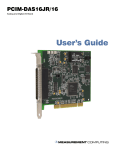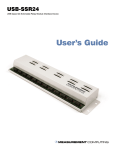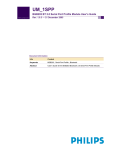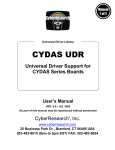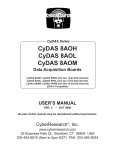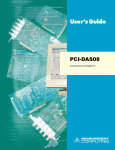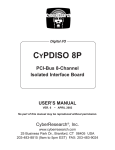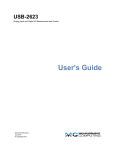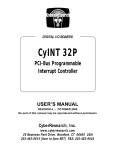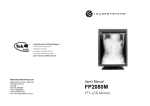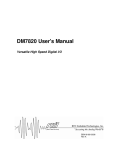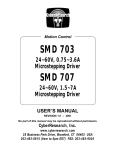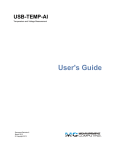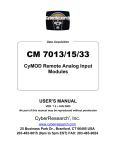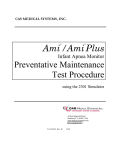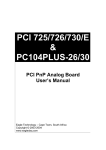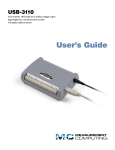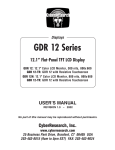Download Installing the CYDAS 16JRHRU
Transcript
® Data Acquisition CYDAS 16JRHRU PCI Data Acquisition Board - 16 Channels of 100kHz 16-bit A/D, 8 DIO USER’S MANUAL VER. 3.0 • MAY 2006 No part of this manual may be reproduced without permission ® CyberResearch , Inc. www.cyberresearch.com 25 Business Park Dr., Branford, CT 06405 USA 203-483-8815 (9am to 5pm EST) FAX: 203-483-9024 ® CyberResearch Data Acquisition CYDAS 16JRHRU ©Copyright 2006 All Rights Reserved. May 1, 2006 The information in this document is subject to change without prior notice in order to improve reliability, design, and function and does not represent a commitment on the part of CyberResearch, Inc. In no event will CyberResearch, Inc. be liable for direct, indirect, special, incidental, or consequential damages arising out of the use of or inability to use the product or documentation, even if advised of the possibility of such damages. This document contains proprietary information protected by copyright. All rights are reserved. No part of this manual may be reproduced by any mechanical, electronic, or other means in any form without prior written permission of CyberResearch, Inc. Trademarks “CyberResearch,” and “CYDAS 16JRHRU,” are trademarks of CyberResearch, Inc. Other product names mentioned herein are used for identification purposes only and may be trademarks and/or registered trademarks of their respective companies. • NOTICE • CyberResearch, Inc. does not authorize any CyberResearch product for use in life support systems, medical equipment, and/or medical devices without the written approval of the President of CyberResearch, Inc. Life support devices and systems are devices or systems which are intended for surgical implantation into the body, or to support or sustain life and whose failure to perform can be reasonably expected to result in injury. Other medical equipment includes devices used for monitoring, data acquisition, modification, or notification purposes in relation to life support, life sustaining, or vital statistic recording. CyberResearch products are not designed with the components required, are not subject to the testing required, and are not submitted to the certification required to ensure a level of reliability appropriate for the treatment and diagnosis of humans. CyberResearch, Inc. 25 Business Park Drive Branford, CT USA iii P: (203) 483-8815; F: (203) 483-9024 www.cyberresearch.com ® CyberResearch Data Acquisition CYDAS 16JRHRU Intentionally Blank iv ©Copyright 2006 CyberResearch, Inc. Table of Contents Preface About this User's Guide ......................................................................................................................vi What you will learn from this user's guide ........................................................................................................vi Conventions in this user's guide....................................................................................................................................... vi Where to find more information ........................................................................................................................vi Chapter 1 Introducing the CYDAS 16JRHRU6 ................................................................................................. 1-1 Overview: CYDAS 16JRHRU features ........................................................................................................ 1-1 Software features ............................................................................................................................................ 1-1 Chapter 2 Installing the CYDAS 16JRHRU ..................................................................................................... 2-1 What comes with your CYDAS 16JRHRU shipment? ................................................................................. 2-1 Hardware ....................................................................................................................................................................... 2-1 Additional documentation.............................................................................................................................................. 2-1 Optional components ..................................................................................................................................................... 2-2 Unpacking the CYDAS 16JRHRU6................................................................................................................ 2-2 Installing the software .................................................................................................................................... 2-2 Default hardware configuration...................................................................................................................... 2-2 Channel mode switch..................................................................................................................................................... 2-3 A/D trigger edge jumper ................................................................................................................................................ 2-4 Clock frequency jumper................................................................................................................................................. 2-4 Installing the CYDAS 16JRHRU .................................................................................................................. 2-5 Connecting the board for I/O operations ........................................................................................................ 2-5 Connectors, cables – main I/O connector....................................................................................................................... 2-5 Pin out – main I/O connector ......................................................................................................................................... 2-6 Cabling........................................................................................................................................................................... 2-6 Field wiring, signal termination, and signal conditioning .............................................................................................. 2-7 Chapter 3 Programming and Developing Applications .................................................................................. 3-1 Programming languages ................................................................................................................................. 3-1 Packaged applications programs..................................................................................................................... 3-1 Register-level programming ........................................................................................................................... 3-1 Chapter 4 Functional Details ............................................................................................................................. 4-1 Analog inputs.................................................................................................................................................. 4-2 Burst mode..................................................................................................................................................................... 4-2 Digital I/O....................................................................................................................................................... 4-3 Counter/timer I/O ........................................................................................................................................... 4-3 Chapter 5 Calibrating the CYDAS 16JRHRU .................................................................................................. 5-1 Calibrating the A/D & D/A converters ........................................................................................................... 5-1 Required equipment ....................................................................................................................................................... 5-1 Chapter 6 Specifications.................................................................................................................................... 6-1 Power consumption ........................................................................................................................................ 6-1 Analog input ................................................................................................................................................... 6-1 iv CYDAS 16JRHRU User's Guide Accuracy ........................................................................................................................................................................ 6-2 Analog input drift........................................................................................................................................................... 6-2 Noise performance......................................................................................................................................................... 6-2 Settling time................................................................................................................................................................... 6-3 Digital input / output....................................................................................................................................... 6-3 Main connector .............................................................................................................................................................. 6-3 Counter ........................................................................................................................................................... 6-4 Environmental ................................................................................................................................................ 6-4 Mechanical ..................................................................................................................................................... 6-4 Main connector and pin out ............................................................................................................................ 6-4 8-channel differential mode pin out ............................................................................................................................... 6-5 16-channel single-ended mode pin out........................................................................................................................... 6-5 v Preface About this User's Guide What you will learn from this user's guide This user's guide explains how to install, configure, and use the CYDAS 16JRHRU so that you get the most out of its analog, digital, and counter I/O features. This user's guide also refers you to related documents available on our web site, and to technical support resources. Conventions in this user's guide For more information on … Text presented in a box signifies additional information and helpful hints related to the subject matter you are reading. Caution! Shaded caution statements present information to help you avoid injuring yourself and others, damaging your hardware, or losing your data. <#:#> Angle brackets that enclose numbers separated by a colon signify a range of numbers, such as those assigned to registers, bit settings, etc. bold text Bold text is used for the names of objects on the screen, such as buttons, text boxes, and check boxes. For example: 1. Insert the disk or CD and click the OK button. italic text Italic text is used for the names of manuals and help topic titles, and to emphasize a word or phrase. For example: The InstaCal® installation procedure is explained in the Quick Start Guide. Never touch the exposed pins or circuit connections on the board. vi Chapter 1 Introducing the CYDAS 16JRHRU Overview: CYDAS 16JRHRU features This manual explains how to install and use the CYDAS 16JRHRU board. The CYDAS 16JRHRU is a multifunction measurement and control board designed to operate in computers with PCI accessory slots. This board can be used for applications such as data acquisition, system timing, and industrial process control. The CYDAS 16JRHRU provides the following features: ! ! ! ! ! ! ! Eight differential or 16 single-ended analog inputs 16-bit A/D resolution 100 kHz sample rate Eight TTL-compatible digital I/O channels Three 16-bit down counters 37-pin high density I/O connector Universal PCI bus (3.3V/5V 32-bit 33 MHz) The analog input mode is switch-selectable for eight differential or 16 single-ended analog inputs. Analog input ranges are selectable with software as bipolar or unipolar. Bipolar input ranges are ±10V, ±5V, ±2.5V and ±1.25V. Unipolar input ranges are 0 to 10V, 0 to 5V, 0 to 2.5V and 0 to 1.25V. The CYDAS 16JRHRU board is equipped with an 82C54 counter chip. This chip contains three 16-bit down counters that provide clock, gate, and output connections. Software features For information on the features of InstaCal and the other software included with your CYDAS 16JRHRU, refer to the Quick Start Guide that shipped with your device. 1-1 Chapter 2 Installing the CYDAS 16JRHRU What comes with your CYDAS 16JRHRU shipment? The following items are shipped with the CYDAS 16JRHRU. Hardware ! CYDAS 16JRHRU Additional documentation In addition to this hardware user's guide, you should also receive the Quick Start Guide (available in PDF at .on the CD accompaning your device. This booklet supplies a brief description of the software you received with your CYDAS 16JRHRU and information regarding installation of that software. Please read this booklet completely before installing any software or hardware. 2-1 CYDAS 16JRHRU User's Guide Installing the CYDAS 16JRHRU Optional components If you ordered any of the following products with your board, they should be included with your shipment. ! Cables CBL 3702 ! CBL 37xxFS Signal termination and conditioning accessories We provide signal termination products for use with the CYDAS 16JRHRU. Refer to the "Field wiring, signal termination and signal conditioning" section on page 2-7 for a complete list of compatible accessory products. Unpacking the CYDAS 16JRHRU As with any electronic device, you should take care while handling to avoid damage from static electricity. Before removing the CYDAS 16JRHRU from its packaging, ground yourself using a wrist strap or by simply touching the computer chassis or other grounded object to eliminate any stored static charge. If any components are missing or damaged, notify CyberResearch, Inc. immediately by phone, fax, or e-mail: ! ! ! Phone: 203-483-9966 and follow the instructions for reaching Tech Support. Fax: 203-483-9024 to the attention of Tech Support Email: [email protected] Installing the software Refer to the Quick Start Guide for instructions on installing the software on the sofware CD. Acquisition Software CD. Configuring the CYDAS 16JRHRU The CYDAS 16JRHRU board has one switch and two jumpers mounted on it. Before installing the CYDAS 16JRHRU in the computer, verify that the board is configured with the settings that you want. Factory default settings are listed in Table 2-1. Table 2-1. Switch/jumper factory-configured defaults Board label Switch/jumper description Default setting S1 P8 P2 Channel mode switch A/D Trigger edge jumper Clock frequency jumper 8 channel (diff) Rising edge 1 MHz The locations of each switch and jumper are shown in Figure 2-1. 2-2 CYDAS 16JRHRU User's Guide Installing the CYDAS 16JRHRU AD Trigger Edge Jumper Channel Mode Switch Clock Frequency Jumper Figure 2-1. CYDAS 16JRHRU switch and jumper locations Instructions on how to change the configuration of each jumper and switch are shown on the following pages. Channel mode switch Switch S1 configures the analog inputs of the CYDAS 16JRHRU as either eight differential channels or 16 single-ended channels. Set the switch to single-ended mode if you have more than eight analog inputs to sample. Setting the switch to differential mode allows up to 10 volts of common mode (ground loop) rejection and provides better noise immunity. The channel mode switch is factory-configured for eight differential inputs (see Figure 2-2.) To configure for 16 single-ended channels, set this switch to "SE". SE DIFF S1 Figure 2-2. Channel mode switch 2-3 CYDAS 16JRHRU User's Guide Installing the CYDAS 16JRHRU A/D trigger edge jumper Jumper P8 configures the edge to initiate the A/D conversion with. The options are either rising or falling edge. The A/D trigger edge jumper is factory-configured for rising edge. Figure 2-3 shows the jumper position for each configuration option. Rising edge A/D trigger DAS-16 method R Default setting F P8 Falling edge A/D trigger DAS-16 method R F P8 P8 Figure 2-3. A/D trigger edge jumper For compatibility with all third-party packages, DAS-16 software, and CYDAS 16JRHRU software, leave this jumper set to the default rising edge position. If you are using the CYDAS 16JRHRU board in an application that is designed for compatibility with the Keithley MetraByte DAS-1600 board, configure the trigger edge jumper for falling edge. Clock frequency jumper Jumper P2 configures the frequency of the square wave that is used as a clock by the A/D pacer circuitry. This pacer circuitry controls the sample timing of the A/D. You can configure the frequency for 10 MHz or 1 MHz. The clock frequency jumper is factory-configured for 1 MHz, as shown in Figure 2-4. 10M CLK SEL P2 1M Figure 2-4. Clock frequency jumper Configure this jumper for 10 MHz, unless you have reason to do otherwise. The internal pacer output is also available at pin 20 The internal pacer output that drives the A/D converter is also available at pin 20 (CTR 3 Output) on the board's main I/O connector (see Figure 2-5). 2-4 CYDAS 16JRHRU User's Guide Installing the CYDAS 16JRHRU Installing the CYDAS 16JRHRU After you configure the board's switches and jumpers, install the CYDAS 16JRHRU into your computer. To install your board, follow the steps below: Install the DAQ software before you install your board The driver needed to run your board is installed with the DAQ software. Therefore, you need to install the DAQ software before you install your board. Refer to the Quick Start Guide for instructions on installing the software. 1. Turn your computer off, open it up, and insert your board into any available PCI slot. 2. Close your computer and turn it on. If you are using an operating system with support for plug-and-play (such as Windows 2000 or Windows XP), a dialog box pops up as the system loads indicating that new hardware has been detected. If the information file for this board is not already loaded onto your PC, you will be prompted for the disk containing this file. The DAQ software contains this file. If required, insert the software CD and click OK. 3. To test your installation and configure your board, run the InstaCal utility installed in the previous section. Refer to the DAQ Software Quick Start that came with your board for information on how to initially set up and load InstaCal. Board configuration with InstaCal If you change the board configuration with InstaCal, you may have to also physically change the setting of a corresponding switch or jumper on the board. Refer to Default hardware configuration on page 2-2 for specific jumper and switch information. Allow your computer to warm up for at least 15 minutes before acquiring data. The high speed components used on the board generate heat, and it takes this amount of time for a board to reach steady state if it has been powered off for a significant amount of time. Connecting the board for I/O operations Connectors, cables – main I/O connector Table 2-2 lists the board connectors, applicable cables, and compatible accessory products for the CYDAS 16JRHRU. Table 2-2. Board connectors, cables, accessory equipment Connector type Connector compatibility Compatible cables Compatible accessory products (with the CBL 37xx cable or CBL 37xxFS cable) 37 pin male "D" connector Identical to the CYDAS 16JRHR connector CBL 370x (Figure 2-6) CBL 37xxFS (Figure 2-7) CYST 37 CYSTP 372P CYSSH 16 The CYDAS 16JRHRU board's main I/O connector is a 37-pin "D" connector that is accessible from the rear of the PC on the expansion back plate. This connector accepts female 37-pin D-type connectors, such as the CBL 370x 37-pin cable (Figure 2-6) or the CBL 37xxFS 37-pin shielded cable (Figure 2-7). Analog connections and configuration General information on analog signal connections and configuration is contained in the Guide to Signal Connections . 2-5 CYDAS 16JRHRU User's Guide Installing the CYDAS 16JRHRU Pin out – main I/O connector CTR 1 Clock In DIG Out 2 DIG Out 0 DIG In 2/CTR1 Gate SS&H Out N/C AGND AGND CH7 High CH6 High CH5 High CH4 High CH3 High CH2 High CH1 High CH0 High 20 21 22 23 24 25 26 27 28 29 30 31 32 33 34 35 36 37 +5V PC Bus Power CTR 1 OUT DIG Out 3 DIG Out 1 DIG In 3 DIG In 1 DIG Gnd N/C N/C N/C Ch7 Low / Ch15 High Ch6 Low / Ch14 High Ch5 Low / Ch13 High Ch4 Low / Ch12 High Ch3 Low / Ch11 High Ch2 Low / Ch10 High Ch1 Low / Ch9 High Ch0 Low / Ch8 High AGND PCI Slot Figure 2-5. Main I/O connector Cabling You can use the CBL 37xx or CBL 37xxFS 37-pin cable to connect signals to the CYDAS 16JRHRU board. The red stripe identifies pin # 1 1 1 20 20 37 37 19 19 Figure 2-6. CBL 37xx cable 1 19 1 20 37 19 Figure 2-7. CBL 37xxFS cable 2-6 20 37 CYDAS 16JRHRU User's Guide Installing the CYDAS 16JRHRU Field wiring, signal termination, and signal conditioning You can use the following screw terminal boards to terminate field signals and route them into the CYDAS 16JRHRU board using a CBL 37xx cable or a CBL 37xxFS cable: ! CYST 37 – 4 x 4, 37-pin screw terminal board. ! CYSTP 372P – 37-conductor, shielded signal connection/screw terminal box that provides two independent 37pin connections. For analog signal conditioning, the following signal conditioning board is compatible with the CYDAS 16JRHRU board. ! CYSSH 16 – 16-channel sample & hold front end board (four channels installed). Details on this product are available from our web site. 2-7 Chapter 3 Programming and Developing Applications After following the installation instructions in Chapter 2, your board should now be installed and ready for use. Although the board is part of the larger DAS family, in general there may be no correspondence among registers for different boards. Software written at the register level for other DAS models will not function correctly with your board. Programming languages CyberResearch's Universal Library™ provides access to board functions from a variety of Windows programming languages. If you are planning to write programs, or would like to run the example programs for Visual Basic or any other language, please refer to the Universal Library User's Guide (available on our web site. Packaged applications programs Many packaged application programs, such as SoftWIRE and HP-VEE™, now have drivers for your board. If the package you own does not have drivers for the board, please fax or e-mail the package name and the revision number from the install disks. We will research the package for you and advise how to obtain drivers. Some application drivers are included with the Universal Library package, but not with the application package. If you have purchased an application package directly from the software vendor, you may need to purchase our Universal Library and drivers. Please contact us by phone, fax or e-mail: ! ! ! Phone: 203-483-9966 and follow the instructions for reaching Tech Support. Fax: 203-483-9024 to the attention of Tech Support Email: [email protected] Register-level programming You should use the Universal Library or one of the packaged application programs mentioned above to control your board. Only experienced programmers should try register-level programming. If you need to program at the register level in your application, refer to the Register Map for the CYDAS 16JRHRU. 3-1 Chapter 4 Functional Details The CYDAS 16JRHRU provides the following features: ! ! ! Eight differential or 16 single-ended 16-bit analog inputs Eight high current digital I/O channels Three 16-bit down counters The block diagram shown here illustrates the functionality of the CYDAS 16JRHRU. Gain and Offset trimpots Mux & Gain Analog In 16 CH S.E. 8 CH DIFF. 1K FIFO 16-Bit,100 kHz Start EOC INT CTR 2 CTR 1 CLK GATE OUT Control ADC Pacer User Counter CTR0 FPGA CONTROLLER Time Base 10MHz 1MHz Bus Timing LOCAL BUS Boot EEPROM PCI CONTROLLER BADR1 BADR2 BADR3 Interrupt PCI BUS (5V/3.3V, Universal 32-BIT, 33MHZ) Figure 4-1. CYDAS 16JRHRU block diagram 4-1 CYDAS 16JRHRU User's Guide Functional Details Analog inputs The analog input mode is switch-selectable for eight differential or 16 single-ended analog inputs. The board offers a 100 kHz maximum sample rate in single and multi-channel scans at any gain setting. A 1024 sample FIFO assures that data taken from the board is transferred into computer memory without the possibility of missed samples. The board has a digital trigger input with software-selectable trigger edge. Software selects the bipolar/unipolar input configuration and input range. Table 4-1 lists the analog input ranges and resolutions for the available input configurations and gains. Table 4-1. Input range and resolution Bipolar Range Resolution Unipolar Range Resolution ±10 V ±5 V ±2.5 V ±1.25 V 305 µV 153 µV 76.3 µV 38.1 µV 0 to 10 V 0 to 5 V 0 to 2.5 V 0 to 1.25 V 153 µV 76.3 µV 38.1 µV 19.1 µV Burst mode Channel-to-channel skew results from multiplexing the A/D inputs. Channel skew is defined as the time between consecutive samples. For example, if four channels are sampled at a rate of 1 kHz per channel, the channel skew is 250 µs (1 ms/4). Burst mode minimizes channel-to-channel skew by clocking the A/D at the maximum rate between successive channels. At the 1-ms pulse, channel 0 is sampled. After 10 µs, channel 1 is sampled. Channel 2 is sampled 10 µs after channel 1 is sampled. Channel 3 is sampled 10 µs after channel 2 is sampled. No samples are then taken until the next 1-ms pulse, when channel 0 is sampled again. In this mode, the rate for all channels is 1 kHz, but the channel-to-channel skew (delay) is now 10 µs. The minimum burst mode skew/delay on this board is 10 µs (refer to Figure 4-2). Ch0 Ch1 Ch2 Ch3 Ch0 Ch1 Ch2 Ch3 10 µS Delay The length of the delay between bursts is set by one of the internal counters, or may be controlled via the external trigger. Figure 4-2. Burst mode timing 4-2 Burst mode pacer is fixed at 10 µS CYDAS 16JRHRU User's Guide Functional Details Digital I/O Eight TTL-compatible digital I/O channels are available on the main I/O connector. Four of the digital channels are configured as input. The remaining four are configured as output. Counter/timer I/O The CYDAS 16JRHRU provides an 82C54 counter chip. This chip contains three 16-bit down counters that provide clock, gate, and output connections. You can connect the counter clock to the on-board 10 MHz crystal oscillator, or leave the counter clock unconnected for user input. 4-3 Chapter 5 Calibrating the CYDAS 16JRHRU The CYDAS 16JRHRU is shipped fully calibrated from the factory. For normal environments, you should calibrate your CYDAS 16JRHRU board using InstaCal's calibration procedures every six months-to-a year. If frequent variations in temperature or humidity are common, recalibrate at least every three months. It requires less than 20 minutes to calibrate the board using InstaCal. Calibrating the A/D and D/A converters InstaCal provides step-by-step on-screen instructions to guide you in calibrating your board. You calibrate the board's A/D converters by applying a known voltage to an analog input channel and adjusting the board’s trim pots for offset and gain. Calibrate the CYDAS 16JRHRU for the range you intend to use it in. Slight variations in zero and full scale may result when the range is changed. These variations can be measured and removed in software, if necessary. Required equipment To calibrate the CYDAS 16JRHRU, you need a precision voltage source, or a non-precision source and a 5½ digit digital voltmeter and a few pieces of wire. Use a jeweler’s screwdriver to adjust the trim pots. An extender card is not required to calibrate the board. 5-1 Chapter 6 Specifications Typical for 25 °C unless otherwise specified. Specifications in italic text are guaranteed by design. Power consumption +5V quiescent +5V available at 37-pin I/O connector 500 mA typical, 750 mA max. Does not include the current consumed through 37-pin I/O connector. 1 A max, protected with re-settable fuse Analog input A/D converter type Resolution Number of channels Input ranges ! Gain is software selectable ! Unipolar / bipolar polarity is software selectable A/D Pacing (software programmable) A/D Trigger (only available when internal pacing selected, software enable/disable) A/D Gate (only available when internal pacing selected, software enable/disable) Simultaneous Sample and Hold trigger Burst mode Data transfer Interrupt Interrupt enable Interrupt polarity Interrupt sources (software programmable) A/D conversion time Throughput Input coupling Input bandwidth (all ranges) Common mode range CMRR @ 60 Hz Recommended warm-up time Input bias current Input impedance Absolute maximum input voltage LTC1605ACSW 16 bits 16 single-ended / 8 differential, switch selectable ±10 V, ±5 V, ±2.5 V, ±1.25 V 0 to 10 V, 0 to 5 V, 0 to 2.5 V, 0 to 1.25 V Internal counter - 82C54. Positive or negative edge, jumper selectable. External source (pin 25), Positive or negative edge, software selectable. Software polled External edge trigger (pin 25), Positive or negative edge, software selectable. External gate (pin 25), High or Low level, software selectable. TTL output (pin 26) Logic 0 = Hold, Logic 1 = Sample Compatible with CYSSH 16 Software selectable option, burst interval = 10 µS From 1024 sample FIFO via interrupt w/ REPINSW Interrupt Software polled INTA# - mapped to IRQn via PCI BIOS at boot-time Programmable through PLX9030 Active high level or active low level, programmable through PLX9030 ! End of conversion ! FIFO not Empty ! End of Burst ! End of Acquisition ! FIFO Half Full 10 µs max. 100 kS/s DC 325 kHz ±10 V min. -100 dB typ., -80 dB min 15 minutes ±3 nA max. 10 M Ohms min. +55/-40V fault protected via input mux. 6-1 CYDAS 16JRHRU User's Guide Specifications Accuracy Typical accuracy Absolute accuracy Accuracy components Gain Error Offset Error PGA linearity error Integral Linearity Error Differential Linearity Error ±2.3 LSB ±5.0 LSB Trimmable by potentiometer to 0 Trimmable by potentiometer to 0 ±1.3 LSB typ., ±10.0 LSB max. ±0.5 LSB typ., ±3.0 LSB max. ±0.5 LSB typ., ±2.0 LSB max. Each CYDAS 16JRHRU is tested at the factory to ensure the board’s overall accuracy error does not exceed ±5 LSB. Total board error is a combination of gain, offset, differential linearity and integral linearity error. The theoretical absolute accuracy of the board may be calculated by summing these component errors. Worst case error is realized only in the unlikely event that each of the component errors are at their maximum level, and causing error in the same direction. Analog input drift Range Analog Input Full-Scale Gain drift Analog Input Zero drift Overall Analog Input drift ±10.00 V ±5.000 V ±2.500 V ±1.250 V 0 - 10.00 V 0 - 5.000 V 0 - 2.500 V 0 - 1.250 V 2.2 LSB/°C max. 2.2 LSB/°C max. 2.2 LSB/°C max. 2.2 LSB/°C max. 4.1 LSB/°C max. 4.1 LSB/°C max. 4.1 LSB/°C max. 4.1 LSB/°C max. 1.8 LSB/°C max. 1.9 LSB/°C max. 2.0 LSB/°C max. 2.3 LSB/°C max. 1.9 LSB/°C max. 2.1 LSB/°C max. 2.4 LSB/°C max. 3.0 LSB/°C max. 4.0 LSB/°C max. 4.1 LSB/°C max. 4.2 LSB/°C max. 4.5 LSB/°C max. 6.0 LSB/°C max. 6.2 LSB/°C max. 6.5 LSB/°C max. 7.1 LSB/°C max. Absolute error change per °C temperature change is a combination of the gain and offset drift of many components. The theoretical worst case error of the board may be calculated by summing these component errors. Worst case error is realized only in the unlikely event that each of the component errors are at their maximum level, and are causing error in the same direction. Noise performance The following table summarizes the worst case noise performance for the CYDAS 16JRHRU. Noise distribution is determined by gathering 50000 samples with inputs tied to ground at the CYDAS 16JRHRU main connector. Data represents both single-ended and differential modes of operation. Range LSBrms Typical Counts ±10.00 V ±5.000 V ±2.500 V ±1.250 V 0 - 10.00 V 0 - 5.000 V 0 - 2.500 V 0 - 1.250 V 1.30 1.30 1.30 1.30 1.80 1.80 1.80 1.80 12 12 12 13 15 15 15 16 6-2 CYDAS 16JRHRU User's Guide Specifications Settling time Settling time is defined here as the time required for a channel to settle to within a specified accuracy in response to a full-scale (FS) step. Two channels are scanned at a specified rate with a –FS DC signal presented to channel 1 and a +FS DC signal presented to channel 0. Condition Same range to same range Range Accuracy ±0.00076% (±4 LSB) ±0.0015% (±8 LSB) ±0.0061% (±16 LSB) ±10 V ±5 V ±2.5 V ±1.25 V Typ. Typ. Typ. Typ. 400 µS 100 µS 60 µS 50 µS 100 µS 20 µS 12 µS 10 µS 10 µS 10 µS 10 µS 0 to 10 V 0 to 5 V 0 to 2 V 0 to 1.25 V Typ. Typ. Typ. Typ. 400 µS 100 µS 60 µS 50 µS 100 µS 20 µS 12 µS 10 µS 10 µS 10 µS 10 µS Digital input / output Main connector Digital output type Digital input type Number of I/O Configuration Output high voltage Output low voltage Input high voltage Input low voltage Data transfer Power-up / reset state 5V/TTL compatible 5V/TTL compatible, pulled to logic high via 10 K resistor network 8 4 fixed input, 4 fixed output 3.8 volts min. @ -32 mA 0.55 volts max. @ 32 mA 2.0 volts min., 7 volts absolute max. 0.8 volts max., -0.5 volts absolute min. Programmed I/O DIG OUT [3:0] - TTL logic low state 6-3 CYDAS 16JRHRU User's Guide Specifications Counter Counter type Configuration Counter 1 source (software selectable) Counter 1 gate Counter 1 output Counter 2 source (jumper selectable at P2) Counter 2 gate (software enable/disable) Counter 2 output Counter 3 source Counter 3 gate (software enable/disable) Counter 3 output Clock input frequency High pulse width (clock input) Low pulse width (clock input) Gate width high Gate width low Input high Input low Output high Output low Crystal oscillator frequency Frequency accuracy 82C54 3 down counters, 16-bits each ! External source from main connector (pin 21*) ! 100 kHz internal source External gate from main connector (pin 24*) Available at main connector (pin 2) ! Internal 1 MHz ! Internal 10 MHz External source from main connector (pin 25*) Internal only, chained to counter 3 source Counter 2 output External source from main connector (pin 25*) Available at main connector (pin 20). Programmable as ADC Pacer clock. 10 MHz max. 30 ns min. 50 ns min. 50 ns min. 50 ns min. 2.0 volts min., 5.5 volts absolute max. 0.8 volts max., -0.5 volts absolute min. 3.0 volts min. @ -2.5 mA 0.4 volts max. @ 2.5 mA 10 MHz 50 ppm * Pins 21, 24, and 25 are pulled to logic high via 10 K resistors. Environmental Operating temperature range Storage temperature range Humidity 0 to 70 °C -40 to 100 °C 0 to 95% non-condensing Mechanical Card dimensions Form factor PCI half card: 136.5 mm (L) x 106.9 mm (W) x 11.65 mm (H) Universal PCI keying. Compatible with 3.3 V/5 V 32-bit, 33 MHz back planes. Main connector and pin out Connector type Connector compatibility Compatible accessory products 37-pin male "D" connector Identical to the CYDAS 16JRHR connector CYSTP 37 CYSSH 16 Compatible cables CBL 37xx CBL 37xxFS 6-4 CYDAS 16JRHRU User's Guide Specifications 8-channel differential mode pin out Pin 1 2 3 4 5 6 7 8 9 10 11 12 13 14 15 16 17 18 19 Signal Name +5V PC BUS POWER CTR 1 OUT DIG OUT 3 DIG OUT 1 DIG IN 3 DIG IN 1 DIG GND NC NC NC CH7 LO CH6 LO CH5 LO CH4 LO CH3 LO CH2 LO CH1 LO CH0 LO AGND Pin 20 21 22 23 24 25 26 27 28 29 30 31 32 33 34 35 36 37 Signal Name CTR 3 OUT CTR 1 CLOCK IN DIG OUT 2 DIG OUT 0 DIG IN 2 / CTR1 GATE DIG IN 0 / EXT TRIG / EXT PACER / EXT GATE SS&H OUT NC AGND AGND CH7 HIGH CH6 HIGH CH5 HIGH CH4 HIGH CH3 HIGH CH2 HIGH CH1 HIGH CH0 HIGH 16-channel single-ended mode pin out Pin 1 2 3 4 5 6 7 8 9 10 11 12 13 14 15 16 17 18 19 Signal Name +5V PC BUS POWER CTR 1 OUT DIG OUT 3 DIG OUT 1 DIG IN 3 DIG IN 1 DIG GND NC NC NC CH15 HIGH CH14 HIGH CH13 HIGH CH12 HIGH CH11 HIGH CH10 HIGH CH9 HIGH CH8 HIGH AGND Pin 20 21 22 23 24 25 26 27 28 29 30 31 32 33 34 35 36 37 Signal Name CTR 3 OUT CTR 1 CLOCK IN DIG OUT 2 DIG OUT 0 DIG IN 2 / CTR1 GATE DIG IN 0 / EXT TRIG / EXT PACER / EXT GATE SS&H OUT NC AGND AGND CH7 HIGH CH6 HIGH CH5 HIGH CH4 HIGH CH3 HIGH CH2 HIGH CH1 HIGH CHO HIGH 6-5 Declaration of Conformity Category: Electrical equipment for measurement, control and laboratory use. The manufacturer declares under sole responsibility that the product CYDAS 16JRHRU to which this declaration relates is in conformity with the relevant provisions of the following standards or other documents: EU EMC Directive 89/336/EEC: Electromagnetic Compatibility, EN55022 (1995), EN55024 (1998) Emissions: Group 1, Class B ! EN55022 (1995): Radiated and Conducted emissions. Immunity: EN55024 ! ! ! ! ! ! ! EN61000-4-2 (1995): Electrostatic Discharge immunity, Criteria A. EN61000-4-3 (1997): Radiated Electromagnetic Field immunity Criteria A. EN61000-4-4 (1995): Electric Fast Transient Burst immunity Criteria A. EN61000-4-5 (1995): Surge immunity Criteria A. EN61000-4-6 (1996): Radio Frequency Common Mode immunity Criteria A. EN61000-4-8 (1994): Power Frequency Magnetic Field immunity Criteria A. EN61000-4-11 (1994): Voltage Dip and Interrupt immunity Criteria A. Declaration of Conformity based on tests conducted by Chomerics Test Services, Woburn, MA 01801, USA in September, 2001. We hereby declare that the equipment specified conforms to the above Directives and Standards. ® CyberResearch Data Acquisition CYDAS 16JRHRU Product Service Diagnosis and Debug CyberResearch, Inc. maintains technical support lines staffed by experienced Applications Engineers and Technicians. There is no charge to call and we will return your call promptly if it is received while our lines are busy. Most problems encountered with data acquisition products can be solved over the phone. Signal connections and programming are the two most common sources of difficulty. CyberResearch support personnel can help you solve these problems, especially if you are prepared for the call. To ensure your call’s overall success and expediency: 1) 2) 3) 4) 5) 6) Have the phone close to the PC so you can conveniently and quickly take action that the Applications Engineer might suggest. Be prepared to open your PC, remove boards, report back-switch or jumper settings, and possibly change settings before reinstalling the modules. Have a volt meter handy to take measurements of the signals you are trying to measure as well as the signals on the board, module, or power supply. Isolate problem areas that are not working as you expected. Have the source code to the program you are having trouble with available so that preceding and prerequisite modes can be referenced and discussed. Have the manual at hand. Also have the product’s utility disks and any other relevant disks nearby so programs and version numbers can be checked. Preparation will facilitate the diagnosis procedure, save you time, and avoid repeated calls. Here are a few preliminary actions you can take before you call which may solve some of the more common problems: 1) 2) 3) 4) Check the PC-bus power and any power supply signals. Check the voltage level of the signal between SIGNAL HIGH and SIGNAL LOW, or SIGNAL+ and SIGNAL– . It CANNOT exceed the full scale range of the board. Check the other boards in your PC or modules on the network for address and interrupt conflicts. Refer to the example programs as a baseline for comparing code. CyberResearch, Inc. 25 Business Park Drive Branford, CT USA 25 P: (203) 483-8815; F: (203) 483-9024 www.cyberresearch.com ® CyberResearch Data Acquisition CYDAS 16JRHRU Intentionally Blank 26 ©Copyright 2006 CyberResearch, Inc. ® CyberResearch Data Acquisition CYDAS 16JRHRU Warranty Notice CyberResearch, Inc. warrants that this equipment as furnished will be free from defects in material and workmanship for a period of one year from the confirmed date of purchase by the original buyer and that upon written notice of any such defect, CyberResearch, Inc. will, at its option, repair or replace the defective item under the terms of this warranty, subject to the provisions and specific exclusions listed herein. This warranty shall not apply to equipment that has been previously repaired or altered outside our plant in any way which may, in the judgment of the manufacturer, affect its reliability. Nor will it apply if the equipment has been used in a manner exceeding or inconsistent with its specifications or if the serial number has been removed. CyberResearch, Inc. does not assume any liability for consequential damages as a result from our products uses, and in any event our liability shall not exceed the original selling price of the equipment. The equipment warranty shall constitute the sole and exclusive remedy of any Buyer of Seller equipment and the sole and exclusive liability of the Seller, its successors or assigns, in connection with equipment purchased and in lieu of all other warranties expressed implied or statutory, including, but not limited to, any implied warranty of merchant ability or fitness and all other obligations or liabilities of seller, its successors or assigns. The equipment must be returned postage prepaid. Package it securely and insure it. You will be charged for parts and labor if the warranty period has expired. Returns and RMAs If a CyberResearch product has been diagnosed as being non-functional, is visibly damaged, or must be returned for any other reason, please call for an assigned RMA number. The RMA number is a key piece of information that lets us track and process returned merchandise with the fastest possible turnaround time. PLEASE CALL FOR AN RMA NUMBER! Packages returned without an RMA number will be refused! In most cases, a returned package will be refused at the receiving dock if its contents are not known. The RMA number allows us to reference the history of returned products and determine if they are meeting your application’s requirements. When you call customer service for your RMA number, you will be asked to provide information about the product you are returning, your address, and a contact person at your organization. Please make sure that the RMA number is prominently displayed on the outside of the box. • Thank You • CyberResearch, Inc. 25 Business Park Drive Branford, CT USA 27 P: (203) 483-8815; F: (203) 483-9024 www.cyberresearch.com ® CyberResearch Data Acquisition CYDAS 16JRHRU Intentionally Blank 28 ©Copyright 2006 CyberResearch, Inc. CyberResearch, Inc. 25 Business Park Drive Branford, CT 06405 USA P: (203) 483-8815; F: (203) 483-9024 www.cyberresearch.com




































